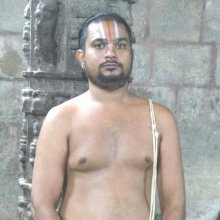Dolotsava, Dola-utsava, Ḍolotsava: 5 definitions
Introduction:
Dolotsava means something in Hinduism, Sanskrit. If you want to know the exact meaning, history, etymology or English translation of this term then check out the descriptions on this page. Add your comment or reference to a book if you want to contribute to this summary article.
Images (photo gallery)
In Hinduism
Pancaratra (worship of Nārāyaṇa)
Source: archive.org: Catalogue of Pancaratra Agama Texts1) Ḍolotsava (डोलोत्सव) refers to the “swing festival”, as discussed in chapter 24 of the Puruṣottamasaṃhitā: a Pāñcarātra text consisting of more than 1800 verses devoted to temple-building and the practical concerns of the Pāñcarātra priestly community.—Description of the chapter [brahmotsava-vidhi]: [...] Each day the procession will employ a different vāhana-vehicle. These are listed (67-79). For special observances within the brahmotsava period, other optional directions are given—[e.g., ḍolotsava (swing festival) on the fourth day (1286-134)] [...] At the discretion of the Ācārya certain other celebrations may thus be added to the brahmotsava cycle (198-202).
2) Ḍolotsava (डोलोत्सव) is the name of a festival, as discussed in the twelfth chapter of the Īśvarasaṃhitā (printed edition), a Pāñcarātra work in 8200 verses and 24 chapters dealing with topics such as routines of temple worship, major and minor festivals, temple-building and initiation.—Description of the chapter [pakṣotsava-vidhi]: [...] The remainder of the chapter is devoted to describing in more detail some of these, and other, festivals; [e.g., ḍolotsava (161-205a);] [...].
3) Ḍolotsava (डोलोत्सव) refers to the “swing festival”, as discussed in chapter 46 of the Śrīpraśnasaṃhitā: a Pāñcarātra text comprising 5500 Sanskrit verses covering a number of subjects ranging from selecting a temple site through building and furnishing it to sanctifying and maintaining worship in the sacred complex.—Description of the chapter [ḍolotsava]: In the months between āśvayuja through magha [October-November through February-March], a 3, 5, or 7 day festival called ḍolotsava may be celebrated on certain evenings. How to construct the swing for this is given (10-12). The main features of this celebration is each day to take the utsavabera-icon to the maṇḍapa where the swing is kept, there to offer it pūjā and, in the evening, a swing-ride (15-43). The reward for supporting this festival is to be released from birth-and-death (44-45a).

Pancaratra (पाञ्चरात्र, pāñcarātra) represents a tradition of Hinduism where Narayana is revered and worshipped. Closeley related to Vaishnavism, the Pancaratra literature includes various Agamas and tantras incorporating many Vaishnava philosophies.
Languages of India and abroad
Sanskrit dictionary
Source: Cologne Digital Sanskrit Dictionaries: Cappeller Sanskrit-English DictionaryDolotsava (दोलोत्सव).—[masculine] a swinging-feast.
[Sanskrit to German]
Sanskrit, also spelled संस्कृतम् (saṃskṛtam), is an ancient language of India commonly seen as the grandmother of the Indo-European language family (even English!). Closely allied with Prakrit and Pali, Sanskrit is more exhaustive in both grammar and terms and has the most extensive collection of literature in the world, greatly surpassing its sister-languages Greek and Latin.
Kannada-English dictionary
Source: Alar: Kannada-English corpusḌōlōtsava (ಡೋಲೋತ್ಸವ):—[noun] a religious service in which the deity is swung on a swing.
--- OR ---
Ḍōḷōtsava (ಡೋಳೋತ್ಸವ):—[noun] = ಡೋಲೋತ್ಸವ [dolotsava].
--- OR ---
Dōlōtsava (ದೋಲೋತ್ಸವ):—[noun] a religious service of swinging the idol of a deity on a swing.
Kannada is a Dravidian language (as opposed to the Indo-European language family) mainly spoken in the southwestern region of India.
See also (Relevant definitions)
Partial matches: Dola, Utsava, Tola.
Starts with: Dolotsavamandapa.
Query error!
Full-text: Doladolotsava, Dolotsavamandapa, Dola, Magha, Jalakrida, Damanika, Madhumasa, Madhumasotsava, Jalakridotsava, Acaryabahumana, Damanikotsava, Ashvayuja, Pakshotsavavidhi, Vishakhotsava, Brahmotsavavidhi, Svapotsava, Vasantotsava.
Relevant text
Search found 5 books and stories containing Dolotsava, Dola-utsava, Ḍola-utsava, Ḍōla-utsava, Dōla-utsava, Ḍōḷa-utsava, Ḍōlōtsava, Ḍolotsava, Ḍōḷōtsava, Dōlōtsava; (plurals include: Dolotsavas, utsavas, Ḍōlōtsavas, Ḍolotsavas, Ḍōḷōtsavas, Dōlōtsavas). You can also click to the full overview containing English textual excerpts. Below are direct links for the most relevant articles:
Garga Samhita (English) (by Danavir Goswami)
Verses 4.15.6-8 < [Chapter 15 - The Story of the Women of Barhiṣmatī-pura, the Apsarās, and the Women of Sutala and Nāgendra]
Temples of Purushottama Kshetra Puri (by Ratnakar Mohapatra)
3. Sculptures of Lord Jagannatha Temple < [Chapter 3 - Lord Jagannatha Temple]
A Brief Survey of the Puranas on the Krishna Lila < [Purana, Volume 11, Part 1 (1969)]
Studies in the Upapuranas (by R. C. Hazra)
Abhijnana Shakuntala (synthetic study) (by Ramendra Mohan Bose)
Chapter 6 - Shashtha-anka (sastho'nkah) < [Abhijnana Sakuntalam, text and commentary]
